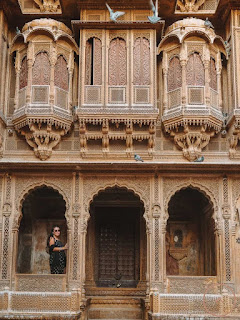The state of Jaisalmer had its foundations in what remains of the Empire ruled by the Bhati dynasty. Early Bhati rulers ruled over large empire stretching from Ghazni in modern day Afghanistan to Sialkot, Lahore and Rawalpindi in modern day Pakistan, to Bhatinda, Muktsar and Hanumangarh in India. The empire crumbled over time because of continuous invasions from central Asia.
Bhati dominions continued to shift towards the south and finally got pushed into Cholistan and Jaisalmer where Rawal Devaraja built Dera Rawal/ Derawar. Jaisalmer was the new capital founded in 1156 by Maharawal Jaisal Singh and the state took its name from the capital.
On 11th December 1818 Jaisalmer became a British protectorate in the Rajputana Agency.
One Rupee coin of Jaisalmer state
Maharawal Jaisal Singh, Jaisalmer Fort
Royal standard of Jaisalmer Princely State
Flag of Jaisalmer over the Jaisalmer Fort
Traditionally, in the Middle Ages, the main source of income for the kingdom was levies on caravans, but the economy was heavily affected when Bombay emerged as a major port and sea trade replaced the traditional land routes.
Maharawals Ranjit Singh and Bairi Sal Singh attempted to turn around the economic decline but could not. A severe drought from 1895 to 1900 made matters worse.
Popularly known as the " Golden City'' owing to the yellow sandstone structures and the gold-coloured desert surrounding it.
Several attempts to modernize by Maharaja Jawahir Singh (1914-1949) were not entirely successful, although some infrastructure development for storage of water, health and sanitation was developed.
After the departure of the British in 1947, the Maharawal signed an instrument of Accession to the Union of India while retaining some internal autonomy until the 1950s. Even now, it is the largest district of Rajasthan with 38,401 square kilometer area and having an international border of 471 km.
Historic Sites in Jaisalmer
Akal Wood Fossil Park , Jaisalmer
The 21-hectare preserved area of the park about 17 km from Jaisalmer, is packed with 180 million years old history. The discovery of wood fossils researched and believed to have been submerged below the ocean generated a lot of interest in geologists, botanist and scientists that led to the area being stripped clean of wood fossils over decades.
Wood Fossils
Now what remains are countable numbers lying under corrugated iron shelters, caged in the desolate desert.
Wood Fossils in caged iron shelters
Jaisalmer Fort. It was built in 1156 AD by Rao Jaisal and is popularly known as "Sone Ka Quila'' or Golden Fort.
Jaisalmer Fort
Standing proudly in the middle of the golden sands, it is one of the only fort that has people staying there now for centuries. It is 460 meters long, 230 meters wide having a basement wall that is 4.6 meters tall forming a double line of defense.
Gadisar Lake. It was built by the founder of Jaisalmer, Rawal Jaisal in 1156 AD, and later rebuilt by Gadsi Singh around 1367 AD. It is an artificial lake.
Gadisar Lake
Patwon ki Haveli. The first Haveli was built in1805 by a wealthy trader in the city called Ghuman Chand Patwa and it took about 55 years to build as he decided to build 5 Haveli's around the complex, one each for his five sons.
Patwa Haveli
Nathmal ki Haveli. Built in the late 19th century by two jeweler brothers by starting work on two opposite sides of the building which resulted in a similar but not identical right and left side.
Nathmal Haveli
Salim Singh ki Haveli. Built in 1815 and commissioned by Salim Singh the then Prime Minister of the kingdom.
Salim Singh Haveli
Kudhara. A village close to Jaisalmer, now in ruins. As per the story there, Salim Singh who was one of the ministers in Jaisalmer, had an eye on a girl in Kuldhara, a settlement of Paliwal Brahmins. He gave the entire village an ultimatum that either they hand over the girl to him or be ready to face the consequences. Instead of handing over the girl, the entire settlement of over 83 villages disappeared. while leaving they cast a curse on the village that none would be able to reside there.
Kuldhara, the village in ruins
Devali script on Cenotaph at Kuldhara village
Obverse: Legend in urdu " Malikah Mu'azzam rafi ud darjat meaning Victoria farman rawai,
Reverse: legend in urdu, "dar al riyasat Jaisalmer/ maimanat manus jalus 22 ie regnal year,
One Rupee, Muhammad Shah, silver, AH 115X, weight 11.3 g, Reverse: Sana julus zarb RY 22 (frozen), Akhey Shahi series





















Such an interesting blog post. Have jaisalmer on my bucket list . Did not know about the wood fossil park there. Thanks. Was there no other script that could be on the coins or was urdu the spoken language in Jaisalmer?
ReplyDeleteWarm regards
Minnie
Wonderful blog post. Very enlightening. Thank you.
ReplyDelete